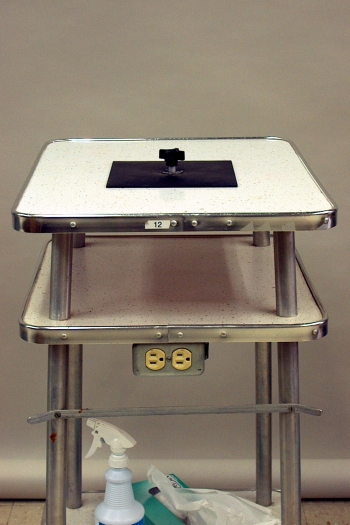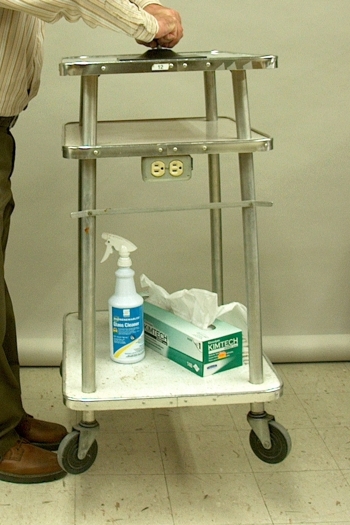 |
 |
 |
 |
Sitting on the projector table in the photographs above is a PASCO atmospheric pressure demonstrator. This is a square of rubber, about 3 mm thick and 20 cm square (so 400 square centimeters or 0.040 square meters), with a handle attached in the center (via a sandwich of metal discs). Slap the demonstrator down on the surface of the projector table, or place it there and press it flat. You can then lift the entire projector table by pulling up on the handle. For this demonstration to work, the surface must be clean, hence the bottle of cleaner and box of wipes on the lower shelf of the projector table.
The atmosphere exerts a pressure all around us of 101,325 Pa. (This also equals 760 torr (mm of mercury) or 14.7 psi.) The pascal equals 1 N/m2. Thus, over the area of the atmospheric pressure demonstrator it exerts a force of 101,325 N/m2 × 0.040 m2 = 4,053 N. If the rubber sheet were strong enough, then, you could lift 4,053 N/9.80 m/s2, or about 414 kg (about 910 lb). If the object were heavier than this, its weight would exceed the total force on the rubber sheet and separate the object from it. The projector table (without cleaner and wipes) weighs 17.6 kg × 9.80 m/s2 = 172 N (38.7 lb), which is about one twenty-fourth of this. The demonstrator easily lifts it off the ground, as shown above in the right-hand photograph.
You can, of course, lift any object that has a smooth, clean surface, free of any scratches that would provide a leak path for air. You can also place the demonstrator on the surface of the main demonstration table and have students try to lift it from the surface. They won’t be able to do this.